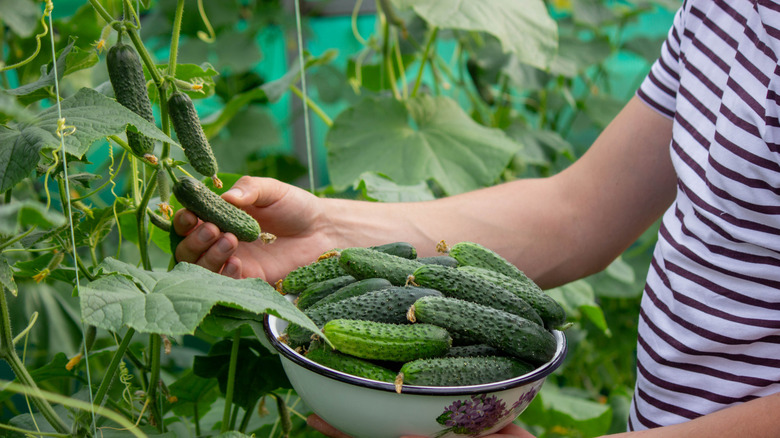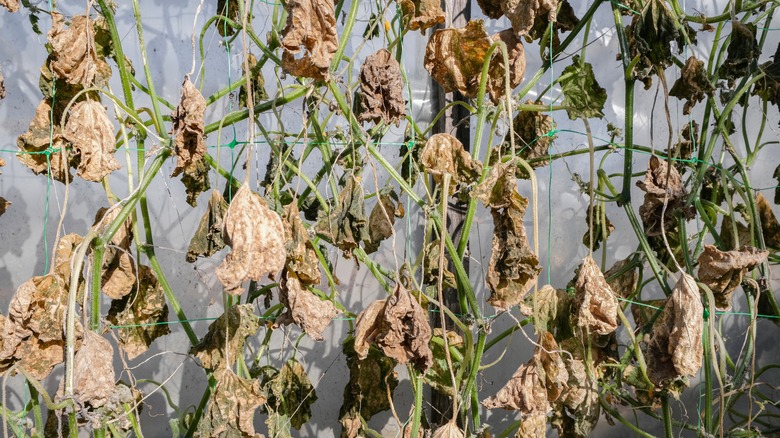Mistakes To Avoid Making When Planting Garden Cucumbers
While you'll find plenty of tips and tricks to optimize fruit production, improve flavor, or speed up growth, the key to healthy cucumbers is not overlooking common garden mistakes like improper planting time, location, or spacing. Even temperature and moisture are very important things to get right when planting cucumbers. Cucumbers are a warm-season crop that needs plenty of heat, but they're also heavy water feeders whose large, thin leaves are prone to drying out quickly.
So your job as a gardener is to keep them consistently warm, but not so hot that fruit production is stunted. You also need to keep them consistently watered, but not so soggy that they develop fungal diseases. The easiest way to do that is to avoid making two mistakes when you're first planting your garden cucumbers. First, don't plant them too early when it's still cold outside. Second, don't plant them so closely together that they don't have room to grow and plenty of air flow, even when they've reached their mature size.
Even if you think it's already warm enough to sow seeds or put out transplants that you started indoors, you might be surprised at just how cold-sensitive these veggies are. Likewise, it's easy to underestimate just how much space these plants need to spread to their mature size without blocking air flow to their neighbors. Keep reading for tips on getting the timing and spacing right as you plant your cucumber bed this season.
Don't plant cucumbers too early
While some veggies can be started on or before your last frost date, cucumbers are not only not frost hardy, they also don't tolerate milder cool temperatures that you might not think of as harmful. The tender plants can start showing symptoms of chilling injury when air temperatures dip below 65 degrees Fahrenheit. Sowing them early won't give you much of a head start on the growing season anyway, as seeds won't sprout until soil temperatures are very warm. Even soil temperatures as high as 50 degrees Fahrenheit are still too cold for cucumber seeds to germinate.
Instead, wait until the top inch of soil in your garden is at least 70 degrees Fahrenheit — but temperatures between 80 and 85 degrees are even better. In colder climates, you can warm up your soil a little faster by using row covers to trap heat and protect young plants from cold air. Just make sure to remove them later in the season when air temperatures are consistently above 65 degrees, even at night.
Along with waiting longer to plant than you might want to, don't make the mistake of planting your cucumbers in the wrong spot. The cold-sensitive veggie should be planted in the warmest, sunniest part of your yard — even in hotter climates. But if summer temperatures are regularly above 90 degrees, you may need to hand-pollinate your plants as heat-stressed bees may not pollinate enough flowers on their own, resulting in a smaller harvest with more misshapen cucumbers.
Avoid planting cucumbers too close together
Another common mistake gardeners make is planting cucumbers too close together. Because they need lots of water, but are also sensitive to fungal diseases, giving them plenty of space for air circulation is key to preventing infection. Make sure to follow the recommended spacing guidelines on your seed packet. There should be enough space between rows to accommodate the cucumber's mature size and allow for airflow between plants.
Another way to avoid wet leaves is to train cucumber vines to grow on a trellis. It's an attractive way to lift vines off the wet ground so they get airflow on all sides, while also giving you easy access to water the soil underneath without splashing the foliage as much. But one of the most common mistakes to avoid when growing cucumbers on a trellis is assuming you can space plants closer together since they'll be growing vertically instead of along the ground. Regardless of where the vines are growing, the roots below ground still need space around them, so you still need to follow the recommended spacing guidelines on your seed packet.
In smaller gardens, succession planting is a good workaround. Instead of crowding your cucumbers, sow seeds every three weeks or so through the season, stopping about three months before your first frost date in fall. This way, each successive batch will reach its mature size at different times. As plants reach their harvest date, remove them to make room for the younger plants that were planted later.


